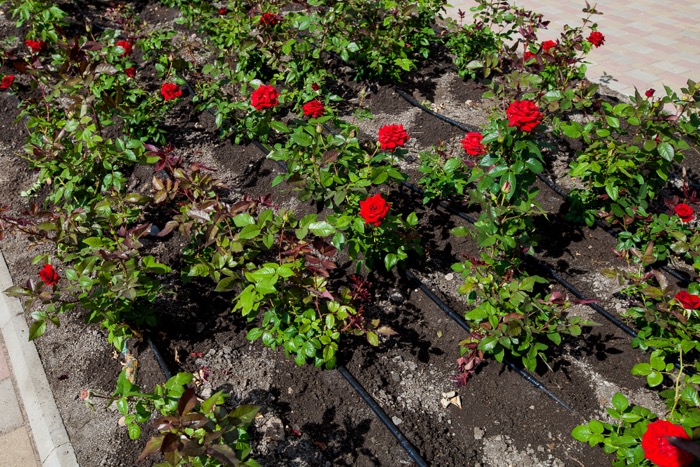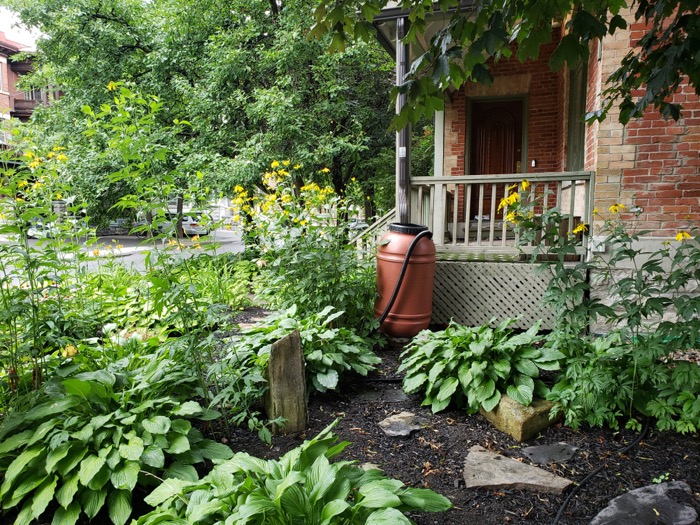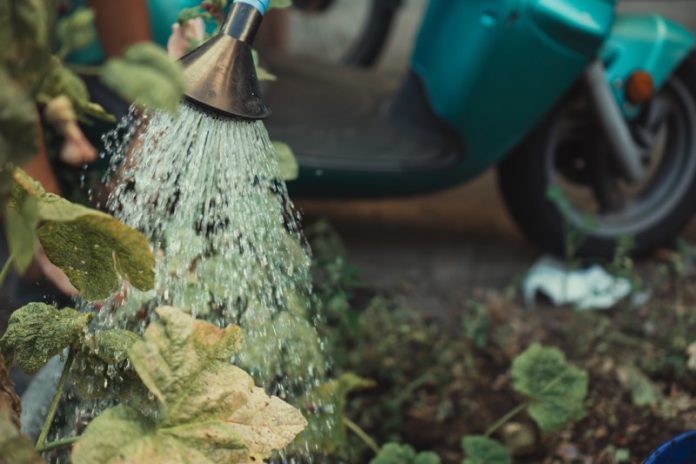Water is the most precious resource in the world. We can’t survive without it nor can our plants. With global warming and climate change, it is imperative that we all do our part to use this resource mindfully. That means finding the best ways to water our plants and gardens to provide adequate moisture to them without carelessly wasting this resource. There are, of course, budget considerations. Most gardeners should be prepared to use a combination of watering methods in their landscape. Don’t forget to use mulch to help retain the moisture after watering.
There are lots of ways to provide water and each has advantages and disadvantages. The watering needs of trees and shrubs are very different from the needs of growing plants in the vegetable garden or perennial bed. Here are some ideas for watering or irrigation in your yard.

Above Ground Sprinklers
The above ground sprinkler is the most common way to water a large area like a vegetable garden. The sprinkler is attached to a hose and placed in the area you want to water. Turn it on and after the ground is soaked, the sprinkler is turned off and usually removed until needed again. There are many different types of sprinklers–from oscillating to circular patterned arm whirling types. Some sprinklers are pulsating or have a sweeping motion.
Many of these sprinklers can be controlled to send water only to a specific area by a setting mechanism that allows you to set the number of degrees you want the sprinkler to cover. Sometimes, the force of the water in the hose is used to regulate the water. If the water is turned on completely, it will give the greatest amount of coverage. If the water is only turned on partially, the amount of area the water reaches will be decreased.
The advantage of this type of system is low cost, portability from one part of your yard to another and some control over the area the water will soak. The disadvantages are the inconvenience of needing to haul the hose and sprinkler out to the area to be watered. The relatively small area that can be watered at one time is a disadvantage, and the water is delivered overhead so plant foliage will get wet, which may not be desirable. There also is more water lost to evaporation with this system and some water may be delivered to hardscape areas like driveways and sidewalks.
In-Ground Sprinklers
The in-ground sprinkler system is installed by burying the pipes underground. The system is divided into zones, which are connected to a control center. The control center will automatically turn on and off the system at the programmed time for each zone. The system can have the sprinkler heads projecting upright in the garden or the system can have sprinkler heads that pop out of the ground when in use only.
The advantage of the system is that it is automatic once set up. No hoses are being hauled around the yard. The program will take care of itself and there’s no need to remember to turn on the water. Another advantage is the zone system. The system can be controlled to give more water to one area and less to others. The way the water is distributed can also be varied. The water can be sprayed overhead, or spot delivered right at the base of the plant itself. This is perfect for plants like roses and tomatoes which are susceptible to diseases when their leaves are wet. The number one disadvantage is the cost. These systems can be very expensive and may require a professional installation. Another disadvantage is the system will turn on at the prescribed time even if it is raining. There are some systems that include a sensor that will prevent the system from turning on if there has been adequate precipitation.
Soaker Hose
A soaker hose is a hose that has multiple small holes along the length of the hose. This allows the water to slowly seep out of the hose and onto the ground. You lay the hose through your garden, winding around the plants. The advantage of this system is it is inexpensive. The soaker hose can remain in place all season and just needs the water turned on when needed. The foliage will remain dry as the water seeps into the ground. The disadvantage is the entire hose will release water so some water will be wasted if it isn’t next to a plant.

Drip Irrigation
Drip irrigation is an intact hose to which the gardener adds emitters to release water exactly where you want it. This is what is used in the nursery greenhouse for their hanging pots. Each pot has an emitter which will water the plant while keeping the foliage dry. The advantage is the ability to water precisely where you want the water–for example, at the base of the rose plant or perennial. Again, the foliage remains dry. The disadvantage is mainly cost. Drip irrigation is more expensive than a soaker hose.

Rain Barrels
Rain barrels are returning to popularity as water conservation becomes more important. In the past, everyone had a rain barrel to collect water and cisterns in the basement for larger amounts of water. Today, the rain barrel has made a comeback. Rain barrels are now made of plastic and are connected to the down spout of your home or garden shed’s gutter system. The water that would have been dumped out into the yard is now collected for use where you need it. The rain barrels can be hooked together, so as one fills, the water will automatically be diverted to the second barrel. They also have an overflow mechanism so the water will not backflow. The rain barrel then has a hose attachment at the bottom so you can attach a soaker hose or drip irrigation hose to the barrel and use the water for your foundation plantings of trees and shrubs or you can fill your watering can to water pots and window boxes. The barrels require a one-time investment and will last for years. The water that would have been wasted is now useful and it is cost-free.
There are lots of ways to provide water to your plants and they come in all price ranges. Even if there isn’t a shortage of water in your area, it still is better for the environment to conserve as much as possible while still keeping our plants well-watered.

